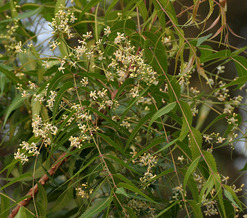AZADIRACHTA INDICA
description & usage
Indigenous to and cultivated nearly all over India and in Burma. It is very popular tree grows in all types of soil. White fragrant flowers are found in branched manner.
Uses :
It is a favourite application in tetanus, leprosy, urticaria, eczema, crysipelas, scrofula and skin disease, like ringworm, scabies, pemphigus, etc.,
How to Use:
A decoction of the bark with little black pepper and chiretta is a popular remedy for fevers. A compound medicated oil consisting of 40 parts of neem oil, 1 part each of haritala, manasila, bhilama, cardamoms, Aloe-root, Sandalwood, root of valeriana hardwickii, and chameli and 100 parts of water, all boiled together and made into oil in the usual way ; used as an application to suppurating scrofulous glands. Kernel of the fruit 1 drachm mixed with 2 drachms of gool and made into a pill, is given daily for 7 consecutive days to cure piles. Leaves heated over boiling water or in the form of pulp or paste (ointment and liniment) or poultice or ground with honey into a lep form antiseptic applications to unhealthy pustules, indolent glandular swellings, boils, ulcers and skin diseases. Leaf-juice is given in worms, jaundice and in skin diseases. Paste of leaves is used externally in cases of small-pox.
Parts Used:
Leaves, flowers, bark
Taste:
Bitterness
Action:
Stimulant, anthelmintic
Uses :
It is a favourite application in tetanus, leprosy, urticaria, eczema, crysipelas, scrofula and skin disease, like ringworm, scabies, pemphigus, etc.,
How to Use:
A decoction of the bark with little black pepper and chiretta is a popular remedy for fevers. A compound medicated oil consisting of 40 parts of neem oil, 1 part each of haritala, manasila, bhilama, cardamoms, Aloe-root, Sandalwood, root of valeriana hardwickii, and chameli and 100 parts of water, all boiled together and made into oil in the usual way ; used as an application to suppurating scrofulous glands. Kernel of the fruit 1 drachm mixed with 2 drachms of gool and made into a pill, is given daily for 7 consecutive days to cure piles. Leaves heated over boiling water or in the form of pulp or paste (ointment and liniment) or poultice or ground with honey into a lep form antiseptic applications to unhealthy pustules, indolent glandular swellings, boils, ulcers and skin diseases. Leaf-juice is given in worms, jaundice and in skin diseases. Paste of leaves is used externally in cases of small-pox.
Parts Used:
Leaves, flowers, bark
Taste:
Bitterness
Action:
Stimulant, anthelmintic


